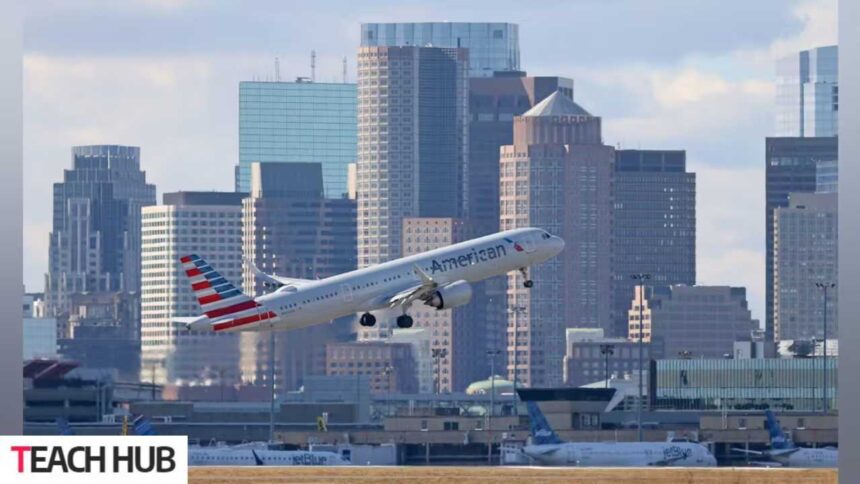Have you ever been on a flight that suddenly became a heart-pounding adventure? Well, let me tell you about American Airlines Flight 457Q. What started as a routine trip from New York to Los Angeles on March 12, 2024, quickly became a nightmare at 37,000 feet. Imagine being up there when the plane starts shaking violently and making scary noises!
But here’s the thing—this story isn’t just about fear. It’s about the incredible skill of the pilots and crew, who kept calm when things got rough. Thanks to their training and quick thinking, what could have been a disaster turned into a tale of a heroic landing.
Want to know how it all went down? Curious about what caused the problem and how everyone reacted? Keep reading to get the full scoop on this wild ride in the sky. Trust me, you will want to take advantage of every detail of this gripping aviation drama!
What Was American Airlines Flight 457Q?
American Airlines Flight 457Q was a daily nonstop service connecting John F. Kennedy International Airport (JFK) in New York to Los Angeles International Airport (LAX). The flight was operated using a state-of-the-art Boeing 787-9 Dreamliner, known for its fuel efficiency and passenger comfort. With a capacity of 285 passengers, the aircraft offered various seating classes to cater to different preferences and budgets.
The Chilling Timeline of Events
The events that unfolded on March 12, 2024, turned what should have been a routine transcontinental flight into a harrowing experience for all involved. Let’s break down the timeline of this dramatic incident:
Takeoff and Initial Climb
At 8:32 am, Flight 457Q took off from JFK as scheduled. The initial climb was smooth, and the aircraft reached its cruising altitude of 37,000 feet without any reported issues. Passengers settled in for what they expected to be a comfortable journey across the country.
The First Signs of Trouble
Approximately two hours into the flight, an observant passenger noticed an unusual rattling sound from the floor near the wings. This passenger promptly alerted a flight attendant, who informed the pilots. At first, the crew didn’t observe any significant issues, but this would soon change.
Escalating Concerns
As the flight progressed towards its destination, the rattling noise became more pronounced and persistent. This escalation raised concerns among the passengers and the crew, creating an atmosphere of unease within the cabin.
The Descent and Violent Shaking
The situation took a dramatic turn around 11:45 am as Flight 457Q began its descent into Los Angeles. The aircraft suddenly experienced violent shaking, catching everyone off guard. The previously concerning rattling noises evolved into loud banging sounds, further intensifying the fear and anxiety on board.
Pilots’ Struggle for Control
During this critical phase, the pilots faced an enormous challenge. They struggled to maintain control of the aircraft as it shook violently. Their experience and training were put to the ultimate test as they worked to ensure the safety of everyone on board.
The Harrowing Landing
After an agonizing 20 minutes of uncertainty and fear, the pilots safely landed Flight 457Q on the runway at LAX. While the landing was successful, it was far from smooth, and the relief of being on the ground was palpable among the passengers and crew.
Post-Landing Assessment
Once on the ground, it became clear that the incident had taken its toll on the aircraft. The fuselage and left engine showed visible signs of damage, highlighting the severity of the flight’s situation.
Eyewitness Accounts and Passenger Experiences
The events that transpired on American Airlines Flight 457Q left a lasting impression on all present. Here are some of the experiences shared by passengers:
The Terrifying Fall: Shortly after takeoff, passengers reported a sudden jolt and a drop in altitude. One passenger described the sensation as if “the plane just fell out of the sky for a few seconds,” causing widespread panic and screams throughout the cabin.
Confusion and Fear: After the initial drop, chaos reigned supreme. Passengers were still determining what had happened and whether they were still in danger. The subsequent violent shaking and rattling noises only heightened fears that the aircraft might be breaking apart.
Praise for the Crew: Despite the challenging circumstances, many passengers commended the professionalism and quick action of the flight crew. Flight attendants were described as “real heroes” for their swift response in checking on passengers and providing reassurance.
Pilot Skill Recognition: Pilots received widespread praise for stabilizing the aircraft and safely landing it under such difficult conditions. Their skill and composure were crucial in averting a potential disaster.
The Investigation and Aftermath
Following the safe but unsettling landing of Flight 457Q, a thorough investigation was launched to determine the cause of the incident. Here are the essential findings and outcomes:
Safe Evacuation: All passengers and crew were evacuated from the aircraft upon landing at LAX. While some individuals sustained minor injuries from the sudden drop and turbulence, there were no severe casualties.
Aircraft Grounding: The Boeing 787-9 Dreamliner involved in the incident was immediately grounded for a comprehensive inspection and investigation.
Mechanical Failure Identified: The investigation revealed that a mechanical failure in the left engine caused the violent shaking and alarming noises experienced during the flight.
Safety Review: The incident prompted a review of the entire American Airlines fleet’s maintenance procedures and safety protocols, mainly focusing on the Boeing 787-9 Dreamliner aircraft.
Passenger Support: American Airlines provided support and compensation to the affected passengers, including counseling services for those who experienced trauma from the incident.
Lessons Learned and Industry Impact
The circumstances surrounding American Airlines Flight 457Q had a profound effect on the aviation sector and produced several noteworthy results, including:
Enhanced Maintenance Protocols
The incident highlighted the importance of rigorous and frequent maintenance checks, especially for newer aircraft models. In response, airlines around the world reviewed and enhanced their maintenance protocols.
Crew Training Emphasis
The crucial role played by the flight crew in managing the crisis underscored the importance of comprehensive and ongoing training for pilots and flight attendants. Many airlines increased their investment in crisis management and emergency response training programs.
Passenger Awareness
The incident reminded passengers of the importance of attending safety briefings and being prepared for unexpected situations during flights.
Technological Advancements
The aviation industry accelerated research and development into more advanced monitoring systems that could detect potential mechanical issues earlier, potentially preventing similar incidents in the future.
Communication Improvements
Airlines and aviation authorities recognized the need for clear and timely communication with passengers and their families during and after such incidents. This led to improvements in crisis communication strategies across the industry.
The Importance of Aviation Safety
The story of American Airlines Flight 457Q powerfully reminds us of the critical importance of aviation safety. While air travel remains one of the safest forms of transportation, incidents like this highlight the ongoing need for vigilance, preparation, and continuous improvement in safety measures.
Critical aspects of aviation safety include:
- Regular and thorough aircraft maintenance
- Rigorous pilot training and certification
- Strict adherence to safety protocols and procedures
- Continuous monitoring and upgrading of safety systems
- Effective communication and coordination among crew members
- Passenger education on safety procedures
The resilience and professionalism demonstrated by the crew of Flight 457Q underscore the value of these safety measures and the human factor in ensuring safe air travel.
(FAQS)
What caused the mechanical Failure on American Airlines Flight 457Q?
The investigation revealed that a mechanical failure in the left engine caused the violent shaking and alarming noises experienced during the flight. The provided information did not disclose the exact details of the Failure.
Were there any serious injuries among passengers or crew?
While some individuals sustained minor injuries from the sudden drop and turbulence, no severe casualties were reported. All passengers and crew were safely evacuated upon landing at LAX.
How did the pilots land the plane safely despite the mechanical issues?
The pilots relied on their extensive training and experience to maintain control of the aircraft during the violent shaking. Their skill in stabilizing the plane and executing a safe landing under challenging conditions was crucial in averting a potential disaster.
What actions did American Airlines take after the incident?
American Airlines grounded the aircraft for a thorough investigation, provided support and compensation to affected passengers, and reviewed maintenance procedures and safety protocols for their entire fleet, mainly focusing on the Boeing 787-9 Dreamliner aircraft.
How common are incidents like Flight 457Q in commercial aviation?
While the exact frequency of such incidents is not provided, the article suggests that such situations are rare in commercial aviation. Air travel remains one of the safest forms of transportation, with continuous efforts to enhance safety measures and protocols.
Conclusion
The harrowing journey of American Airlines Flight 457Q serves as a testament to the importance of aviation safety, crew training, and emergency preparedness.
While the incident was undoubtedly terrifying for those involved, the successful landing and minimal injuries highlight the effectiveness of modern safety protocols and the skill of well-trained aviation professionals.
As the industry continues to learn from such events and implement improvements, air travel remains one of the safest forms of transportation, with incidents like Flight 457Q serving as valuable learning experiences for the entire aviation community.



